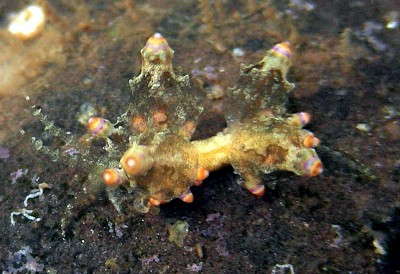
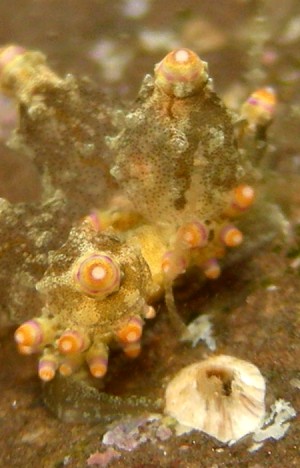
Eubranchus mandapamensis
(Rao, 1968)
Suborder: AEOLIDINA
Family: Eubranchidae
DISTRIBUTION
Originally described from Mandapam in south-eastern India. Possibly has a widespread Indo-West Pacific distribution.
PHOTO
Rock patch, Mandavi, Ratnagiri, 0.5 feet, Maharashtra, India, Arabian Sea, 08 February 2009, below rock in the Rock pool, Intertidal with . Length: 10 mm. Photographer: Vishal Bhave.
Originally described from Mandapam in south-eastern India, the characteristic external features of this species include the shape and colour of the cerata and the rhinophores.
The cerata are inflated with two rings of rounded tubercles. The original description describes grey spots all over the body and orange patches on the cerata. Also described is a 'bright yellowish orange band .. on the subapical region of the cerata, and another pink or purple-coloured band just below the subapical region'. The rhinophores are described as having 'three to five annulations at equal distance'.
Terry Gosliner suggested to me some years ago that he thought Eubranchus rubropunctatus and E. mandapamensis to be synonyms but I felt there were enough inconsistencies in Rao's description to wait until we had more information. Vishal Bhave's photos certainly match Rao's description of E. mandapamensis quite well and certainly link Edmund's description of the cerata of E. rubropunctatus with two subapical ceratal yellow bands and a bluish band with red spots between, with Rao's description of an orange band near the tip with a pink or purple-coloured band just below.
However E. rubropunctatus has distinct papillae scattered over the rhinophores while Rao clearly describes and draws evenly spaced annulations on the rhinophores. A third 'form' I have seen has smooth rhinophores [Eubranchus cf. rubropunctatus from Hong Kong].
While it is possible that one species could have this degree of rhinophoral variability I can't think of an example. At this stage I suggest we take a conservative approach and keep the three rhinophore types separate until we know more about the anatomy and variability of this species or group of species.
-
Gosliner, T. 1990. Additions to the aeolidacean fauna of the tropical eastern Pacific. Western Society of Malacologists Annual Report, 22: 16.
-
Rao, K. P. 1968. On a new genus and some new species of opisthobranchiate gastropods of the family Eubranchidae from the Gulf of Mannar. Proceedings of the Symposium on Mollusca held at Cochin from January 12 to 16, 1968. Symposium series 3, part 1, pp. 51-60. Marine Biological Association of India, Mandapam Camp, India.
Rudman, W.B., 2009 (May 15) Eubranchus mandapamensis (Rao, 1968). [In] Sea Slug Forum. Australian Museum, Sydney. Available from http://www.seaslugforum.net/find/eubrmand
Related messages
Eubranchus rubropunctatus or E. mandapamensis
April 13, 2010
From: Lawrence Neal
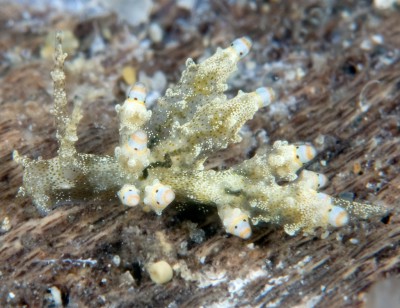
Concerning message #4869:
Dear Bill,
Here are a couple of photos of Eubranchus rubropunctatus from the Andaman Sea. Both of these individuals were found on the underside of an old wooden log, lying on sand close to the shore. Both are about the same size, around 8-10 mm.
The pictures show the pale blue band on the cerata with characteristic small dark reddish spots. One individual has orange-pale blue-yellow bands on the cerata, while the other one has orange-pale blue-orange bands.
Locality: Tablamu, 6 metres, Phangnga, Thailand, Andaman Sea, 20 March 2010, Decaying tree trunk on rocky shore. Length: 8 mm. Photographer: Lawrence Neal.
Best regards,
Lawrence
lorenzo_n@yahoo.com
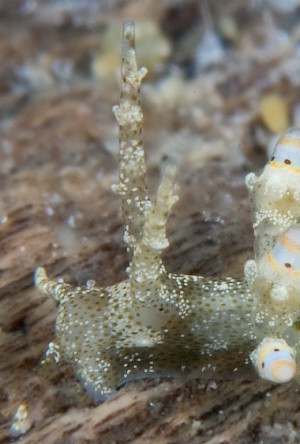
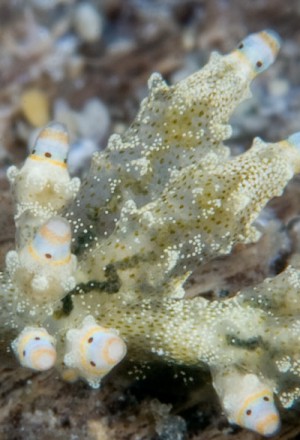
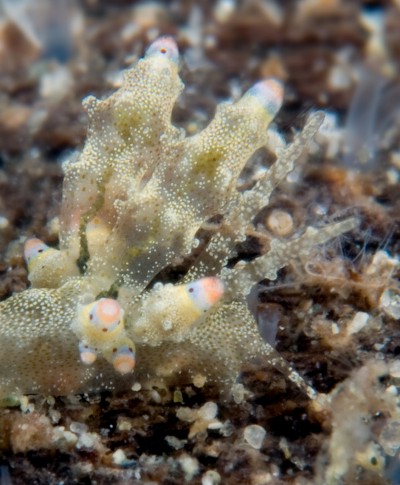
Dear Lawrence,
In an earlier message [#22443] I discussed whether E. rubropunctatus was different from E. mandapamensis or not. The main difference was whether the rhinophores had scattered papillae [E. rubropunctatus] or regular rings [E. mandapamensis]. I think your animals are about halfway between so I tend to think that we should consider there is just one species, the earliest name being E. mandapamensis.
It would be nice for someone to compare the two radular types or to find both forms living together.
Best wishes,
Bill Rudman
Re: Eubranchus mandapamensis from Ratnagiri, India
May 20, 2009
From: Vishal Bhave

Dear Bill,
I found this under an intertidal rock encrusted with hydroids. This slug was also found at Mandavi under the rock in the same pool in which Eubranchus mandapamensis was found [message #22443 ].
Locality: Rock patch, Mandavi,Ratnagiri, 0.5 feet, Maharashtra, India, Arabian sea, 08 February 2009, below rock in the Rock pool, Intertidal with . Length: 8 mm. Photographer: Vishal Bhave.
Vishal Bhave.
vishalbhave@gmail.com


Dear Vishal,
This appears to be just another colour form of E. mandapamensis, in which the purplish band is very obvious and the fine brown spots all over the body are a lighter colour. If you look carefully at the rhinophores the rings, when present, are edged in white. Some of the rings seemed to be broken into a ring of a few white-tipped tubercles. This also suggest a link with Thompson's E. rubropunctatus, but in that species the tubercles on the cerata seem to be randomly arranged rather than in rings. As I said earlier, we still have a lot to learn about variability in this group of species.
Best wishes,
Bill Rudman
Eubranchus mandapamensis from Ratnagiri, India
May 15, 2009
From: Vishal Jayant Bhave
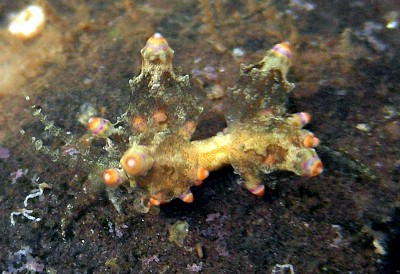
Concerning message #4869:
Dear Bill,
I found this under and intertidal rock encrusted with hydroids. I have doubts about the synonomy of Eubranchus rubropunctatus Edmunds, 1969 and Eubranchus mandapamensis Rao, 1968 (as per nudipixel link http://www.nudipixel.net/species/eubranchus_mandapamensis/)
Locality: Rock patch, Mandavi,Ratnagiri, 0.5 feet, Maharashtra, India, Arabian sea, 08 February 2009, below rock in the Rock pool, Intertidal with . Length: 10 mm. Photographer: Vishal Bhave.
Vishal Bhave
vishalbhave@gmail.com
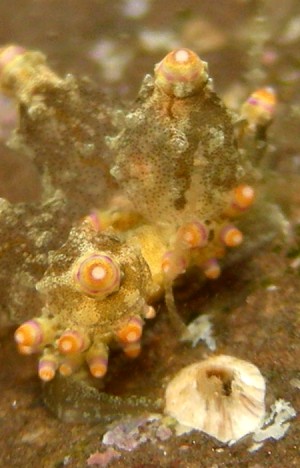
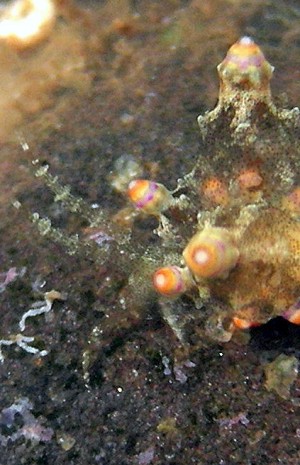
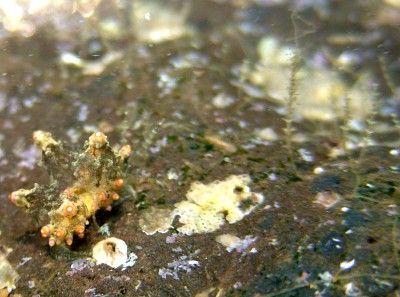
Dear Vishal,
Thanks for these photos. Terry Gosliner suggested to me some years ago that he thought E. rubropunctatus and E. mandapamensis to be synonyms but I felt there were enough inconsistencies in Rao's description to wait until we had more information. Your photo certainly matches Rao's description of E. mandapamensis quite well and certainly links Edmund's description of the cerata having two subapical ceratal yellow bands with a bluish band with red spots between, with Rao's description of an orange band near the tip with a pink or purple-coloured band just below.
However Edmund's E. rubropunctatus has distinct papillae scattered over the rhinophores while Rao clearly describes and draws evenly spaced annulations on the rhinophores. In fact Rao erected a new genus for this species - Annulorhina - to recognise these ringed rhinophores. A third 'form' I have seen has smooth rhinophores [Eubranchus cf. rubropunctatus from Hong Kong]. Looking at the nudipixel site you refer to I can see examples of the three rhinophore types.
While it is possible that one species could have this degree of rhinophoral variability I can't think of another example. At this stage I suggest we take a conservative approach and keep the three rhinophore types separate until we know more about the anatomy and variability of this species or group of species. These are not the only species of eubranchids with fine brown specks and inflated tuberculate cerata. One other species Rao described in the same paper, Capellinia fuscannulata, is almost certainly what I am calling Dunga ocellata on the Forum.
-
Gosliner, T. 1990. Additions to the aeolidacean fauna of the tropical eastern Pacific. Western Society of Malacologists Annual Report, 22: 16.
-
Rao, K. P. 1968. On a new genus and some new species of opisthobranchiate gastropods of the family Eubranchidae from the Gulf of Mannar. Proceedings of the Symposium on Mollusca held at Cochin from January 12 to 16, 1968. Symposium series 3, part 1, pp. 51-60. Marine Biological Association of India, Mandapam Camp, India.
Best wishes,
Bill Rudman
